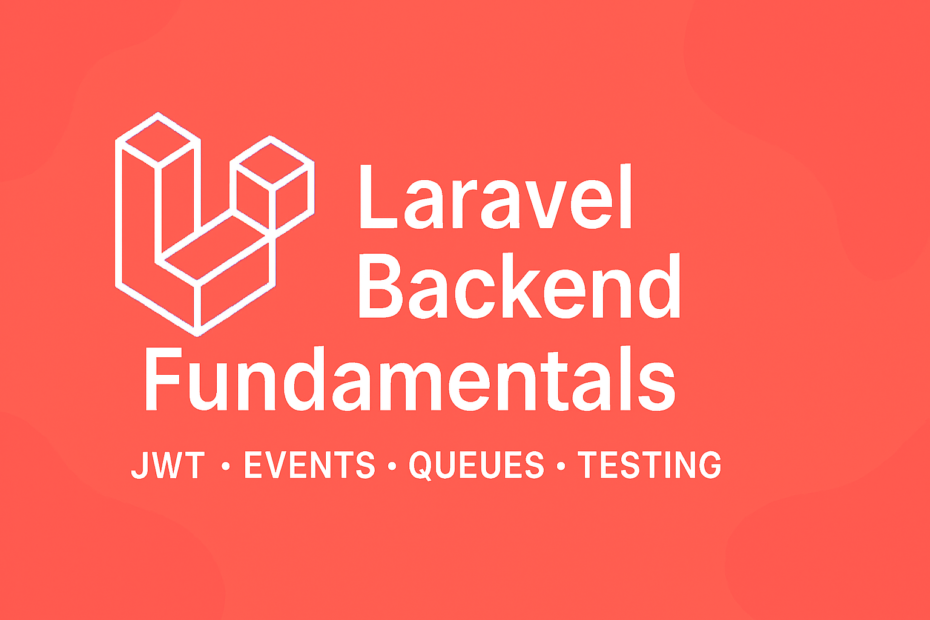Laravel’s backend architecture is a powerhouse of modern PHP development. Whether you’re building APIs, scaling applications, or writing maintainable code, mastering Laravel’s backend fundamentals—like JWT authentication, event-driven design, queues, and testing—can elevate your development game.
In this post, we’ll break down each concept with practical insights and example-driven clarity.
🔐 JWT Authentication: Stateless and Secure
JWT (JSON Web Token) is the go-to method for stateless API authentication. Unlike session-based auth, JWT doesn’t rely on server-side storage, making it ideal for mobile apps and SPAs.
How it works:
- User logs in → Server generates a JWT → Token is sent to the client
- Client stores the token (usually in localStorage) and sends it with each request
- Server verifies the token using a secret key
Laravel Implementation:
Use the popular package tymon/jwt-auth:
composer require tymon/jwt-auth
php artisan vendor:publish --provider="Tymon\JWTAuth\Providers\LaravelServiceProvider"
php artisan jwt:secretThen, update your User model and auth.php config to use jwt as the driver. You’ll get methods like auth()->attempt() and auth()->user() out of the box.
⚡ Events: Decoupled and Reactive
Laravel’s event system lets you decouple logic and react to application changes without cluttering your controllers or models.
Use Cases:
- Send welcome emails after registration
- Log user activity
- Trigger notifications
Example:
// Event
class UserRegistered {
public function __construct(public User $user) {}
}
// Listener
class SendWelcomeEmail {
public function handle(UserRegistered $event) {
Mail::to($event->user->email)->send(new WelcomeMail());
}
}
// Register in EventServiceProvider
protected $listen = [
UserRegistered::class => [SendWelcomeEmail::class],
];Dispatch the event like this:
event(new UserRegistered($user));🧵 Queues: Async and Scalable
Queues allow you to defer time-consuming tasks like email sending, file processing, or API calls—keeping your app fast and responsive.
Setup:
Choose a driver (database, redis, sqs, etc.) in .env:
QUEUE_CONNECTION=databaseRun:
php artisan queue:table
php artisan migrate
php artisan queue:workExample Job:
class ProcessPodcast implements ShouldQueue {
public function handle() {
// Heavy lifting here
}
}Dispatch it:
ProcessPodcast::dispatch();Use retryUntil, backoff, and timeout for robust job handling.
🧪 Testing: Confident and Clean Code
Laravel makes testing a first-class citizen with PHPUnit and its expressive testing syntax.
Types:
- Unit Tests: Test isolated logic
- Feature Tests: Test HTTP endpoints, middleware, database interactions
Example Feature Test:
public function test_user_can_register() {
$response = $this->post('/api/register', [
'name' => 'Sadique',
'email' => 'sadique@example.com',
'password' => 'secret',
]);
$response->assertStatus(201);
$this->assertDatabaseHas('users', ['email' => 'sadique@example.com']);
}Use factories, seeders, and RefreshDatabase trait to keep tests clean and repeatable.
🚀 Final Thoughts
Mastering these backend fundamentals—JWT for secure APIs, Events for clean architecture, Queues for performance, and Testing for reliability—will make your Laravel apps robust and production-ready.
Whether you’re building SaaS platforms, mobile backends, or internal tools, these patterns are essential for scaling and maintaining quality code.
Fuel my creative spark with a virtual coffee! Your support keeps the ideas percolating—grab me a cup at Buy Me a Coffee and let’s keep the magic brewing!
